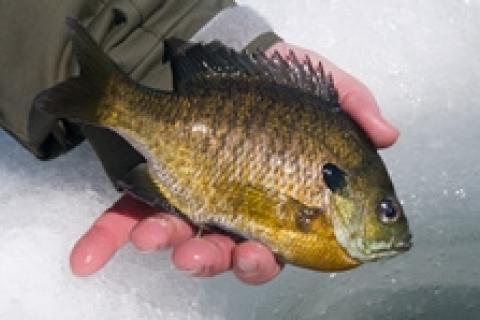
 In many parts of the ice belt there's still lots of ice on lakes, but the end of the hard-water season is fast approaching. This bookend phase is one my favorite times of the year to wet a line. Temperatures are mild and fish are feeding.
In many parts of the ice belt there's still lots of ice on lakes, but the end of the hard-water season is fast approaching. This bookend phase is one my favorite times of the year to wet a line. Temperatures are mild and fish are feeding.
One reliable panfish area is a large, fertile bay. Primo locations will be fed by a tributary. Crappie, yellow perch and sunfish stage in and around bays. This is partly to do with pre-spawn positioning, but they're also foraging on an array of edibles.
Panfish may be in several locations. A high-percentage spot is the bay's outside weed edge. Look for fingers in the weedline that extend into deep water as these will be access routes that fish use to move into the greenery. Crappie are notorious for suspending off these areas during the day, but will storm the shallows at dusk to feed. Peppering a zigzag hole pattern along a weed edge is a good way to sift through this area and contact fish.
Weed clumps and beds within the bay also deserve attention. Panfish, especially bluegills and pumpkinseeds, hunker down among vegetation stalks. Drilling lots of holes and working a bait-tipped ice jig through the greenery is a reliable strategy for catching weed-living sunfish. An underwater camera is useful for seeing areas that are vacant and the ones that are overcrowded with sunnies.
Sand or rock openings in the weeds are always worth fishing. On clear water lakes I've watched schools of perch cruise along these edges during many late-ice adventures. Having lots of holes drilled to be able to follow the wandering school is a good strategy.
While late ice can provide incredible action, safety should always be your priority. The reality is that ice is never 100 percent safe, and as winter ends ice conditions become increasingly unpredictable, inconsistent and change rapidly throughout the day. Exercise caution at all times and when in doubt don't go on the ice. After all, you can always invest the time to prepare for the open-water season.
If you do venture out, don't fish alone and wear a flotation suit or a life jacket over your outerwear. Carry all the safety essentials (throw rope, ice picks, ice cleats, etc.) and have spare clothes in the car in case you get wet. Regularly test the ice with a chisel and drill holes and measure thickness as you go. Lastly, leave a detailed itinerary with someone at home.
Bays offer phenomenal late-ice action for panfish, but safety must always take precedence.
- 2460 views

